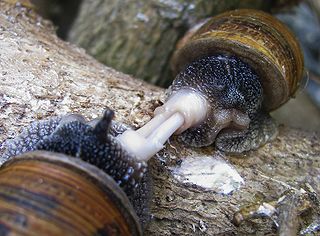
Sexual dimorphism is the condition where the two sexes of the same species exhibit different characteristics beyond the differences in their sexual organs. The condition occurs in many animals and some plants. Differences may include secondary sex characteristics, size, weight, colour, markings, and may also include behavioral and cognitive differences. These differences may be subtle or exaggerated, and may be subjected to sexual selection and natural selection. The opposite of dimorphism is monomorphism.

Pica is the genus of seven species of birds in the family Corvidae in both the New World and the Old.

Voles are small rodents that are relatives of lemmings and hamsters, but with a stouter body; a shorter, hairy tail; a slightly rounder head; smaller ears and eyes; and differently formed molars. They are sometimes known as meadow mice or field mice in North America and Australia.

The gelada, sometimes called the bleeding-heart monkey or the gelada "baboon", is a species of Old World monkey found only in the Ethiopian Highlands, with large populations in the Semien Mountains. Geladas are actually not baboons but the only living members of the genus Theropithecus. Theropithecus is derived from the Greek root words for "beast-ape". Like its close relatives the baboons, it is largely terrestrial, spending much of its time foraging in grasslands.

The Syngnathidae is a family of fish which includes seahorses, pipefishes, and seadragons. The name is derived from Greek, σύν (syn), meaning "together", and γνάθος (gnathos), meaning "jaw". This fused jaw trait is something the entire family has in common.

Sequential hermaphroditism is a type of hermaphroditism that occurs in many fish, gastropods, and plants. Sequential hermaphroditism occurs when the individual changes its sex at some point in its life. In particular, a sequential hermaphrodite produces eggs and sperm at different stages in life. Species that can undergo these changes from one sex to another do so as a normal event within their reproductive cycle that is usually cued by either social structure or the achievement of a certain age or size.

A male (♂) organism is the physiological sex that produces the gamete known as sperm. A male gamete can fuse with a larger female gamete, or ovum, in the process of fertilization. A male cannot reproduce sexually without access to at least one ovum from a female, but some organisms can reproduce both sexually and asexually. Most male mammals, including male humans, have a Y chromosome, which codes for the production of larger amounts of testosterone to develop male reproductive organs. Not all species share a common sex-determination system. In most animals, including humans, sex is determined genetically; however, species such as Cymothoa exigua change sex depending on the number of females present in the vicinity. Male can also be used to refer to gender.

Apodida is an order of littoral to deep-sea, largely infaunal holothurians. This order comprises three families, 32 genera and about 270 known species, called apodids.

Pipefishes or pipe-fishes (Syngnathinae) are a subfamily of small fishes, which, together with the seahorses and seadragons, form the family Syngnathidae.

A polyphenic trait is a trait for which multiple, discrete phenotypes can arise from a single genotype as a result of differing environmental conditions. It is therefore a special case of phenotypic plasticity.

The California sheep head is a species of wrasse native to the eastern Pacific Ocean. Its range is from Monterey Bay, California, to the Gulf of California, Mexico. This species can live for up to 20 years in favorable conditions and can reach a size of up to 91 cm (3 ft) and a weight of 16 kg (35 lb). They are carnivorous, living in rocky reef and kelp bed habitats, feeding primarily on sea urchins, molluscs, and crustaceans.
The mechanisms of reproductive isolation are a collection of evolutionary mechanisms, behaviors and physiological processes critical for speciation. They prevent members of different species from producing offspring, or ensure that any offspring are sterile. These barriers maintain the integrity of a species by reducing gene flow between related species.

The southern grasshopper mouse or scorpion mouse is a species of the order Rodentia, and is in the family Cricetidae. It is found in Mexico and in Arizona, California, Nevada, New Mexico, and Utah in the United States. Notable for its resistance to venom, it routinely kills and eats Arizona bark scorpions, a species with a highly venomous sting.

The yellow-pine chipmunk is a species of order Rodentia in the family Sciuridae. It is found in western North America: parts of Canada and the United States.

In reproductive biology, a hermaphrodite is an organism that has complete or partial reproductive organs and produces gametes normally associated with both male and female sexes. Many taxonomic groups of animals do not have separate sexes. In these groups, hermaphroditism is a normal condition, enabling a form of sexual reproduction in which either partner can act as the "female" or "male". For example, the great majority of tunicates, pulmonate snails, opisthobranch snails, earthworms, and slugs are hermaphrodites. Hermaphroditism is also found in some fish species and to a lesser degree in other vertebrates. Most plants are also hermaphrodites.

Female is the sex of an organism, or a part of an organism, that produces non-mobile ova. Barring rare medical conditions, most female mammals, including female humans, have two X chromosomes. Female characteristics vary between different species with some species containing more well defined female characteristics, such as the presence of pronounced mammary glands. There is no single genetic mechanism behind sex differences in different species and the existence of two sexes seems to have evolved multiple times independently in different evolutionary lineages.
Semelparity and iteroparity are two classes of possible reproductive strategies available to living organisms. A species is considered semelparous if it is characterized by a single reproductive episode before death, and iteroparous if it is characterized by multiple reproductive cycles over the course of its lifetime. Some botanists use the parallel terms monocarpy and polycarpy.
Bateman's principle, in evolutionary biology, is that in most species, variability in reproductive success is greater in males than in females. It was first proposed by Angus John Bateman (1919–1996), an English geneticist. Bateman suggested that, since males are capable of producing millions of sperm cells with little effort, while females invest much higher levels of energy in order to nurture a relatively small number of eggs, the female plays a significantly larger role in their offspring's reproductive success. Bateman’s paradigm thus views females as the limiting factor of parental investment, over which males will compete in order to copulate successfully.

Rhinogobiops nicholsii, the blackeye goby, is a species of true goby in the family Gobiidae. It is the sole species classified under the genus Rhinogobiops. They are common inhabitants of coral reefs and rocky habitats along the Eastern Pacific Ocean coasts of Mexico, the United States, and Canada, though they are hardly noticed, as they often rest motionless near their shelters. Other common names for the species include bluespot goby and crested goby.















